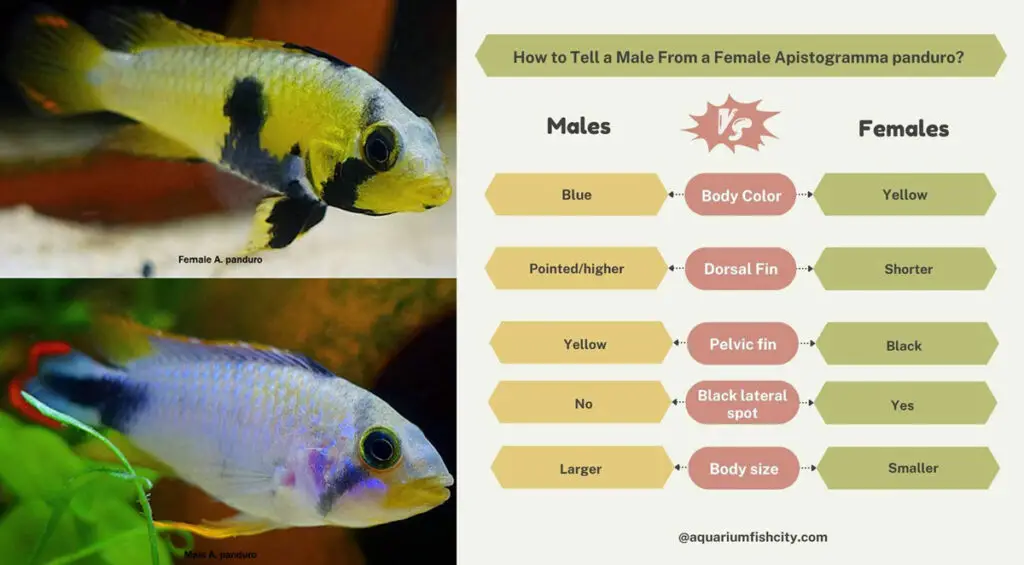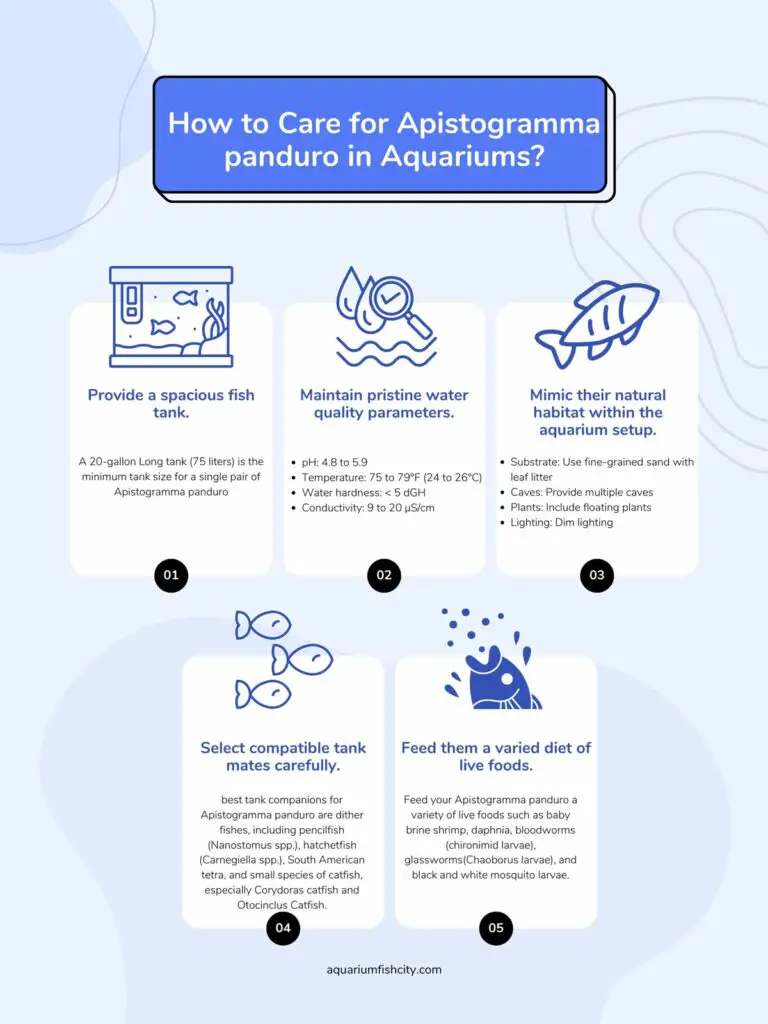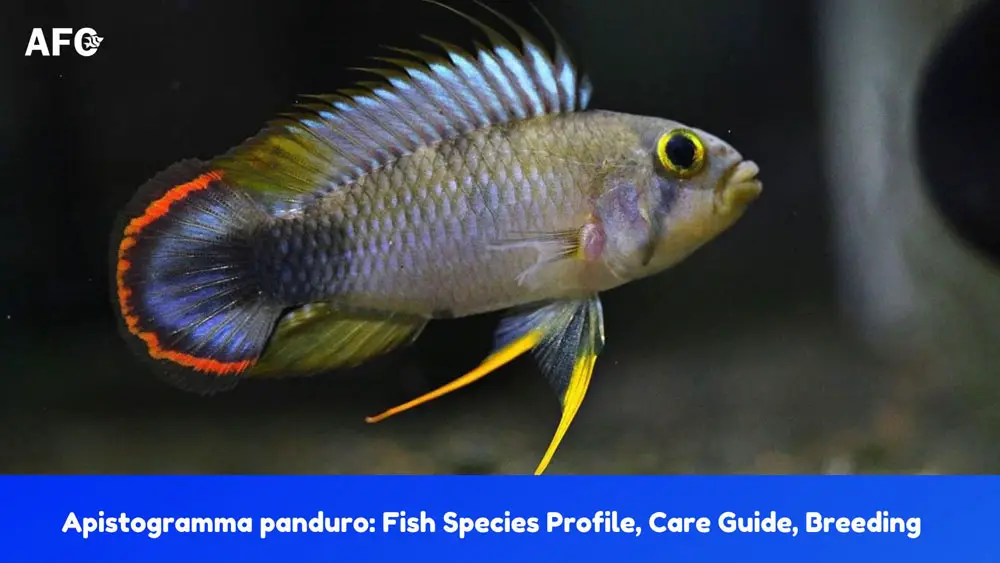Apistogramma panduro, also known as Apistogramma pandurini, the azure cichlid, or blue panda cichlid, is an endemic species found exclusively in the lower Ucayali River in Peru. A. panduro is often mistaken for A. nijsseni due to their similar natural habitat, but they have easily identifiable differences, despite belonging to the same taxonomic species group.
This medium-sized Apistogramma species exhibits sexual dimorphism, with obvious sexual differences between males and females. Males are typically larger and more colorful than females.
Apistogramma panduro are more aggressive than some of the more commonly kept species because they tend to be highly selective when it comes to choosing their mates.
Moreover, these fish are demanding about water quality. They require soft, acidic, and tannin-stained water to thrive and reproduce.
Read on to learn all about the beautiful Apistogramma panduro, how to keep them thriving, and promote successful reproduction in your home aquarium.
What is The Native Habitat of Apistogramma panduro?
Apistogramma panduro is native to a relatively small range in the wild, mainly inhabiting small, slow-moving forest creeks and nearby puddles in the lower Ucayali River in Peru. These regions are characterized by soft, acidic, and light yellow tannin-stained water.
In their natural habitat, A. panduro lives at the river bottom, which consists of white sand, fallen tree branches, and leaf litter, providing them with perfect places for hiding and spawning.
This species was considered a domestic color strain of A. nijsseni because of their similar native habitats and colors.
What Are the Differences Between A. panduro Versus A. nijsseni?
Some of the most notable differences between mature A. panduro and A. nijsseni are as follows.
- Dorsal fin: The first 6 dorsal rays of the A. panduro male are well separated and have sharp spines. The dorsal fins of A. nijsseni males are lower and have relatively even height.
- Caudal fin spot: The black spot at the base of the caudal (or tail) fin of the A. panduro male is large and lance-shaped, with the tip extending into the caudal fin. The caudal spot of A. nijsseni males is small and round.
- Gill covers (operculum): The facial area of A. panduro females is covered by cheek stripes that vary from a thin stream to a broad patch. In A. nijsseni females, the bottom half of the operculum is completely black.
- Patch on the flank: The patches on the lower part area of A. panduro females appear as either broad vertical bars or a large spot that is located in half of the body side. A. nijsseni females have a distinct, oval-shaped dark spot starting from the dorsal fin.
It is difficult to tell A. panduro from A. nijsseni in young fish, as the gender differences are not entirely developed.
How to Tell a Male From a Female Apistogramma panduro?
Here are some of the ways to tell a male from a female Apistogramma panduro.
- Coloration: Males exhibit a predominant blue coloration, while females take on a bright yellow color.
- Dorsal fin: Males have higher and longer dorsal fins than females.
- Oval-shaped dark spot: Females develop a prominent, oval-shaped dark spot on half of their body. This spot is typically absent in males.
- Pelvic fins: In females, the anterior part of the pelvic fins is black, which is yellowish in males.
- Size: Males tend to be a bit larger than females.
Juvenile fish smaller than 1.4 inches (3.5 cm) do not display distinct differences between the sexes, but the pelvic fins of females may appear blacker than in males.

How Big do Apistogramma panduro Get?
The maximum total length for Apistogramma panduro males has been documented as 3.5 inches TL (9 cm), although the average size is usually 3 inches TL (7.5 cm). Females tend to remain a bit smaller, typically staying below 2.4 inches TL (6 cm). This information comes from a 1997 study by Uwe Römer entitled “Diagnoses of two new dwarf cichlids (Teleostei; Perciformes) from Peru, Apistogramma atahualpa and Apistogramma panduro n. spp.”
Are Apistogramma panduro Aggressive?
Yes, Apistogramma panduro are a relatively aggressive species, especially with regard to breeding. Like other members of the A. nijsseni species group, they tend to have opportunistically monogamous relationships and form short-term pairs during the breeding season.
Both sexes are very particular about their partners, and an unsuccessful breeding attempt can lead them to search for a new partner. This selectivity often contributes to their aggressive behavior.
In addition, the females are exceptionally protective of their eggs and fry. They may attack males who attempt to spawn with them again in small-sized breeding aquariums.
What Is The Minimum Tank Size For Apistogramma panduro?
The minimum tank size for a compatible pair of Apistogramma panduro is 20 gallons Long (75 liters). It is highly recommended to keep them in a large group of at least three males and 4-6 females so that they can display social behavior. In this case, a 40-gallon breeder tank (150 liters) should be used.
How Long Do Apistogramma panduro Live?
The average lifespan of Apistogramma panduro is around two years, according to a 1991 statistical study conducted by Dr. Sven O. Kullander on Apistogramma longevity. The study included 7,532 tank-raised specimens from 23 different Apistogramma species.
However, many owners have reported that their fish have lived for up to 5 years if given the proper care. Simulating their natural habitat can help them to reach their full potential.
How to Care for Apistogramma panduro in Aquariums?
Here are the main care requirements for keeping Apistogramma panduro in home aquariums.
- Provide a spacious fish tank.
- Maintain pristine water quality parameters.
- Mimic their natural habitat within the aquarium setup.
- Select compatible tank mates carefully.
- Feed them a varied diet of live foods.
Provide a spacious fish tank.
A 20-gallon Long tank (75 liters) is the minimum tank size for a single pair of Apistogramma panduro. It may seem like too much, whether you want to set up a community tank or breed them. However, there are several good reasons for this size.
First, the more water you have, the more stable the water chemistry will be. This is important for Apistogramma panduro, as they are sensitive to water quality changes.
Second, these fish are territorial, and they need plenty of open space to establish their territories. A larger tank will give them the space they need to feel comfortable and secure.
Third, a larger tank allows you to create a more diverse environment. This includes providing plenty of hiding places for the fish to retreat to when they feel threatened.
Lastly, the larger the aquarium, the more fish you can keep in it. In fact, breeders usually start with a trio of Apistogramma panduro instead of a pair in case they don’t pick the right couple.
Maintain pristine water quality parameters.
The ideal water parameters for Apistogramma panduro are as follows.
- pH: 4.8 to 5.9
- Temperature: 75 to 79°F (24 to 26°C)
- Water hardness: < 5 dGH
- Conductivity: 9 to 20 µS/cm
These are the physical and chemical water parameter values found in their native habitats. Because Apistogramma panduro do require soft water, you will need to invest in a reliable RODI (reverse osmosis de-ionized) water system to remove calcium and magnesium ions from your tap water.
To drive down the pH in water with high levels, peat moss, catappa, and other leaves can be used. However, simply adding them to your hard, alkaline tap water will have no effect on the pH but increase your TDS a bit and tint the water.
Mimic their natural habitat within the aquarium setup.
Aquarium substrate, caves, plants, and lighting are the most important environmental components regarding suitable habitat for Apistogramma panduro.
For the substrate, use fine-grained sand (0.5-1.7 mm grain size). No matter the Apistogramma types, they are the members of the Eartheater Cichlid family who like to stir and sift the substrates to look for food. A finer sandy substrate covered by a layer of leaf litter is the safest way to achieve the desired habitat.
Multiple caves are an absolute requirement for Apistogramma panduro. Treated flower pots, plastic piping, commercial Apistos caves, and coconut shells are recommended. Driftwood, branches, and rocks used to mark territorial boundaries should also be provided.
As for plants, Apistogramma fish appreciate the presence of floating plants and a few robust stems. They will make the fish feel most comfortable.
For lighting, these fish are bottom-dwellers that don’t really need bright lighting. Many aquarists even like to put a dark background on the sides of the tank to dim lighting.
Select compatible tank mates carefully.
The best tank companions for Apistogramma panduro are dither fishes, including pencilfish (Nanostomus spp.), hatchetfish (Carnegiella spp.), South American tetra, and small species of catfish, especially Corydoras catfish and Otocinclus Catfish.
Dither fish are small, peaceful, schooling fish that tend to mostly hang out in the middle to the surface levels of the tank. Not only do they diffuse the Apistos’ aggression towards each other, but they also help to reduce stress levels.
The members of Corydoras catfish and Otocinclus Catfish are adorable, and they are known for their cleaning abilities. They will help to keep uneaten food and other debris off the substrate, as well as aerate it with their feeding activities.
Keep in mind that species of tetra and catfish will eat apisto’s eggs or fry. Instead, go for a group of pencilfish in your breeding tanks. Their small mouths and low bioload make them an ideal choice.
Feed them a varied diet of live foods.
Ideally, feed your Apistogramma panduro a variety of live foods such as baby brine shrimp, daphnia, bloodworms (chironimid larvae), glassworms(Chaoborus larvae), and black and white mosquito larvae. Ignore both Tubifex and blackworms for the sake of water quality.
They will accept frozen foods as well if live food is not available or too costly. You can also culture and grow your own live foods, such as daphnia and brine shrimp.

How to Breed Apistogramma panduro?
Below is a complete guide full of tips and tricks to help you breed Apistogramma panduro in your home aquarium.
Step 1: Acquire a Breeding Pair
The biggest difficulty seems to be finding a compatible breeding pair of Apistogramma panduro.
You can buy a pair from reputable breeders online, such as Aquaticclarity, JDAquatics, Dan’s Fish, and Tristan’s Tropical Fish, or from individual breeders on Aquabid and The Band app.
The cheaper and easier way to obtain a breeding pair is by purchasing a large group of at least two males and 4- 6 females when they are juveniles and raising them together, which will ensure having at least one or two breeding pairs.
Step 2: Set up a Separate Breeding Tank
Set up a separate breeding tank with the same water parameters and décor as the main tank. However, it is recommended to keep the pH around 5.0 because the pH level plays an important role in the sex ratio of the offspring, and this value will ensure you get a ratio of 1:1.
Step 3: Introduce a Trio of Fish to The Tank
Hand-picking one of the most colorful males and two females and introducing them to the breeding tank. If you already have an established pair, you can carefully transfer them instead.
Step 4: Condition the Pair/ Trio with Live Food
Live food is an important part of the diet for breeding fish. It provides them with the nutrients they need to be healthy and spawn successfully.
Step 5: Monitor the Bonding Behavior
Keep a close eye on the bonding behavior if you have a trio in the tank. A compatible breeding pair will attack the female who is not chosen. Try to provide a refuge for the unselected female to avoid her from being harassed.
Like Apistogramma cacatuoides or other apistos, the courtship begins with the female displaying to the male outside a potential nest. The male will then respond with the tail beating.
Step 6: Look at the Spawning Behavior
If breeding is successful, the female can lay approximately 70 eggs in a single spawn. After the eggs are laid, the female often blocks off the entrance to the cave by piling up a heap of sand in front of it.
The whole process, from the rituals of courting to laying eggs, can take as short as one hour.
After around 2-3 days, the fry will hatch, and they will be able to swim on their own around a week later, depending on the water temperature.
Step 7: Observe the Behavior of the Brooding Female
Generally, the female allows the male to be near the fry, but many individuals chase the male away when it comes time for fry care.
Once the female guards over her own fry, she will become highly aggressive and chase any intruders (male or female) away from the fry. It’s best to remove the male at this stage to prevent any fights.
Step 8: Raise Apistogramma panduro Fry
Initially, the fry are too small for anything but infusoria. After a couple of weeks, as the fry grow bigger, they can be fed newly hatched brine shrimp.
Regular water changes of 10% daily are critical for the health and growth of fish during this period.
As long as they are properly cared for, the fry will reach full sexual maturity after around 4 months.






